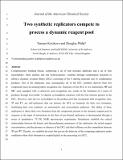Files in this item
Two synthetic replicators compete to process a dynamic reagent pool
Item metadata
| dc.contributor.author | Kosikova, Tamara | |
| dc.contributor.author | Philp, Douglas | |
| dc.date.accessioned | 2020-01-22T00:35:03Z | |
| dc.date.available | 2020-01-22T00:35:03Z | |
| dc.date.issued | 2019-02-20 | |
| dc.identifier.citation | Kosikova , T & Philp , D 2019 , ' Two synthetic replicators compete to process a dynamic reagent pool ' , Journal of the American Chemical Society , vol. 141 , no. 7 , pp. 3059-3072 . https://doi.org/10.1021/jacs.8b12077 | en |
| dc.identifier.issn | 0002-7863 | |
| dc.identifier.other | PURE: 257614946 | |
| dc.identifier.other | PURE UUID: 362e1e4c-6ad3-40ad-a3e5-985827b466fb | |
| dc.identifier.other | Scopus: 85061846334 | |
| dc.identifier.other | ORCID: /0000-0002-9198-4302/work/56639247 | |
| dc.identifier.other | WOS: 000459642000039 | |
| dc.identifier.uri | https://hdl.handle.net/10023/19329 | |
| dc.description | This work was supported by the award of a Postgraduate Studentship from Engineering and Physical Sciences Research Council (EP/K503162/1) to TK and by the University of St Andrews. | en |
| dc.description.abstract | Complementary building blocks, comprising a set of four aromatic aldehydes and a set of four nucleophiles—three anilines and one hydroxylamine—combine through condensation reactions to afford a dynamic covalent library (DCL) consisting of the eight starting materials and 16 condensation products. One of the aldehydes and, consequently, all of the DCL members derived from this compound bear an amidopyridine recognition site. Exposure of this DCL to two maleimides, Mp and Mm, each equipped with a carboxylic acid recognition site, results in the formation of a series of products through irreversible 1,3-dipolar cycloaddition reactions with the four nitrones present in the DCL. However, only the two cycloadducts in the product pool that incorporate both recognition sites, Tp and Tm, are self-replicators that can harness the DCL as feedstock for their own formation, facilitating their own synthesis via autocatalytic and cross-catalytic pathways. The ability of these replicators to direct their own formation from the components present in the dynamic reagent pool in response to the input of instructions in the form of preformed replicators is demonstrated through a series of quantitative 19F{1H} NMR spectroscopy experiments. Simulations establish the critical relationships between the kinetic and thermodynamic parameters of the replicators, the initial reagent concentrations, and the presence or absence of the DCL and their influence on the competition between Tp and Tm. Thus, we establish the rules that govern the behavior of the competing replicators under conditions where their formation is coupled tightly to the processing of a DCL. | |
| dc.format.extent | 14 | |
| dc.language.iso | eng | |
| dc.relation.ispartof | Journal of the American Chemical Society | en |
| dc.rights | Copyright © 2019 American Chemical Society. This work has been made available online in accordance with the publisher’s policies. This is the author created, accepted version manuscript following peer review and may differ slightly from the final published version. The final published version of this work is available at https://doi.org/10.1021/jacs.8b12077 | en |
| dc.subject | QD Chemistry | en |
| dc.subject | DAS | en |
| dc.subject | BDC | en |
| dc.subject | R2C | en |
| dc.subject.lcc | QD | en |
| dc.title | Two synthetic replicators compete to process a dynamic reagent pool | en |
| dc.type | Journal article | en |
| dc.description.version | Postprint | en |
| dc.contributor.institution | University of St Andrews. School of Chemistry | en |
| dc.contributor.institution | University of St Andrews. EaSTCHEM | en |
| dc.contributor.institution | University of St Andrews. Biomedical Sciences Research Complex | en |
| dc.identifier.doi | https://doi.org/10.1021/jacs.8b12077 | |
| dc.description.status | Peer reviewed | en |
| dc.date.embargoedUntil | 2020-01-22 |
This item appears in the following Collection(s)
Items in the St Andrews Research Repository are protected by copyright, with all rights reserved, unless otherwise indicated.

